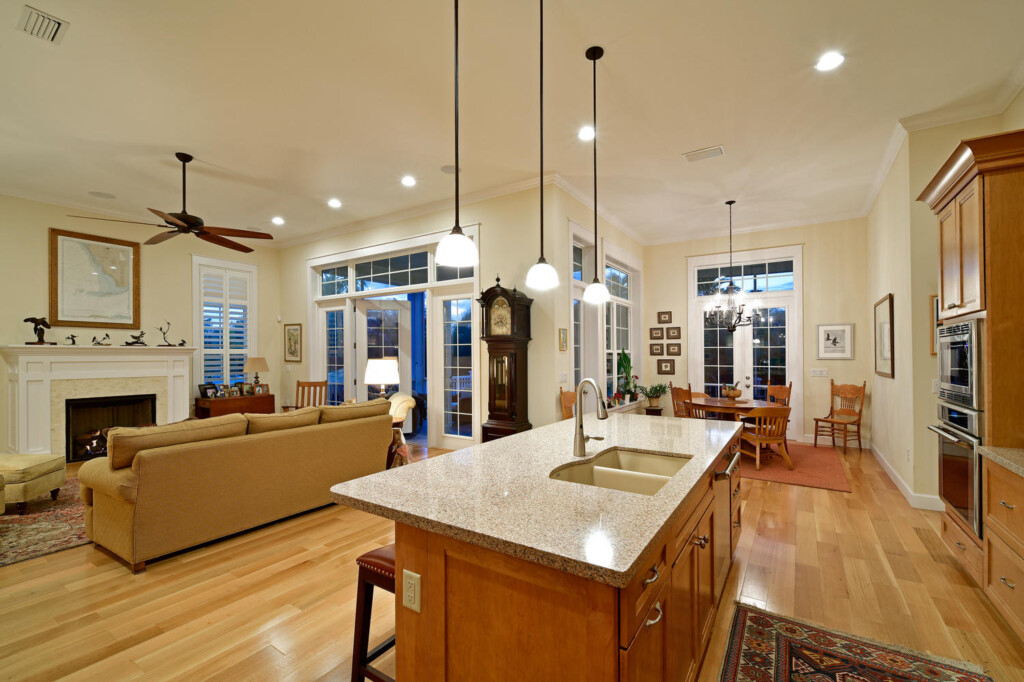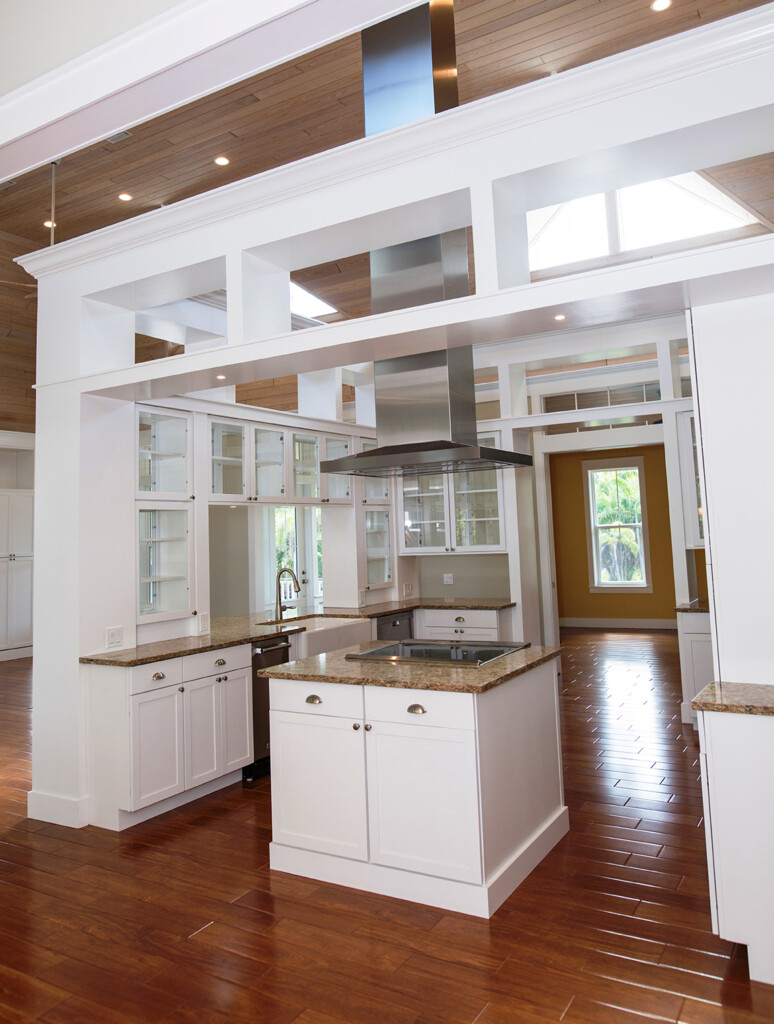The kitchen is the centerpiece of the home, so the mood it sets is important. Kitchen lighting plays a meaningful role in both the functionality and aesthetic appeal of this essential space in the home. Whether preparing a meal, hosting a dinner party, or simply relaxing with a cup of coffee, the type and quality of lighting used can drastically affect the kitchen’s atmosphere and mood. When designing a new custom home (or renovating your old kitchen) understanding the different kinds of kitchen lighting and their impact will help you to create a well-lit and efficient cooking environment and gathering place.

Task Lighting: Functionality at Its Best
Task lighting is primarily focused on providing illumination for specific activities. In a kitchen, this includes areas where detailed work such as chopping, cooking, and cleaning occurs. Task lighting is essential to ensure safety and efficiency, as inadequate lighting can lead to accidents or mistakes in food preparation.
- Under-cabinet lighting is one of the most common forms of task lighting, illuminating the countertop areas where food preparation takes place. These lights help reduce shadows and provide direct light for cutting, measuring, and other detailed tasks.
- Pendant lights over an island or breakfast bar also serve as task lighting by providing focused light on a workspace. Choosing bright, cool-toned LEDs for task lighting ensures the area is well-lit without causing eye strain.
- Task lighting is particularly important for those who enjoy cooking, as it creates a well-defined, bright work zone. Furthermore, adjustable task lighting, such as that offered by dimmable LEDs, can cater to different needs, from high-intensity work lighting to softer settings for a more relaxed cooking atmosphere.
Ambient Kitchen Lighting: Setting the Tone
Ambient lighting is the overall, diffused light that fills the kitchen space. This type of lighting ensures there is enough general illumination for safe movement throughout the kitchen and creates a welcoming environment. It provides a comfortable level of brightness that can be enhanced or subdued to fit the desired mood.
Ceiling-mounted fixtures like flush mounts or chandeliers provide effective ambient lighting for kitchens. These can be combined with light-diffusing elements like frosted glass or fabric shades to soften the glow and reduce harshness. Recessed lighting is also commonly used for ambient light, especially in kitchens with lower ceilings where space is limited.
The impact of ambient lighting on a kitchen’s atmosphere is significant. Bright ambient lighting can energize the space and encourage social interaction, making it perfect for family gatherings or dinner parties. On the other hand, dimmed ambient lighting helps set a relaxed tone for quieter moments, making it ideal for evening meals or intimate conversations.
Accent Kitchen Lighting: Adding Drama and Style
Accent lighting adds visual interest and is primarily used to highlight design features or architectural elements within the kitchen. This type of lighting does not serve a practical purpose in terms of task or ambient illumination but is key to elevating the kitchen’s aesthetic appeal. It can also be used to highlight artwork, open shelving, or textured walls.
Track lighting or wall-mounted spotlights can be directed toward specific areas to create a focal point. LED strip lights are often placed under cabinets or along shelves to provide subtle illumination that highlights the kitchen’s best features. Accent lighting is perfect for creating a sophisticated atmosphere, and it can be especially effective in modern or minimalist kitchen designs, where the focus is on clean lines and open space.
The impact of accent lighting is largely psychological, as it adds depth and dimension to the room. It can help draw attention to particular areas and create a mood that makes the kitchen feel more personalized and stylish.

Natural Light: A Sustainable and Refreshing Option
Although not a type of artificial lighting, natural lighting plays an essential role in a kitchen’s overall illumination. Large windows and skylights can flood the space with natural light, which is not only free and sustainable but also has numerous benefits for both physical and mental well-being.
Natural light enhances the kitchen by creating a bright, airy environment. The inclusion of natural lighting can reduce the reliance on artificial lights, leading to lower energy consumption and promoting a healthier environment. Moreover, it connects the interior space with the outdoors, adding a sense of openness.
Bruce Williams Homes: Inspiration and Experience
The impact of kitchen lighting is multifaceted, influencing both the functionality and aesthetic of the space. Each type of lighting serves a distinct purpose, and when combined thoughtfully, they can significantly improve both the form and function of a kitchen.
When designing your dream kitchen, lighting can make a significant impact – and you can trust the experts at Bruce Williams Homes to provide the insight and inspiration you need. We’ve been building custom homes in Sarasota and Manatee County for over 50 years – but we treat every client with the attention they deserve.
The kitchen is the centerpiece of the home, so the mood it sets is important. Kitchen lighting plays a meaningful role in both the functionality and aesthetic appeal of this essential space in the home. Whether preparing a meal, hosting a dinner party, or simply relaxing with a cup of coffee, the type and quality of lighting used can drastically affect the kitchen’s atmosphere and mood. When designing a new custom home (or renovating your old kitchen) understanding the different kinds of kitchen lighting and their impact will help you to create a well-lit and efficient cooking environment and gathering place.

Task Lighting: Functionality at Its Best
Task lighting is primarily focused on providing illumination for specific activities. In a kitchen, this includes areas where detailed work such as chopping, cooking, and cleaning occurs. Task lighting is essential to ensure safety and efficiency, as inadequate lighting can lead to accidents or mistakes in food preparation.
- Under-cabinet lighting is one of the most common forms of task lighting, illuminating the countertop areas where food preparation takes place. These lights help reduce shadows and provide direct light for cutting, measuring, and other detailed tasks.
- Pendant lights over an island or breakfast bar also serve as task lighting by providing focused light on a workspace. Choosing bright, cool-toned LEDs for task lighting ensures the area is well-lit without causing eye strain.
- Task lighting is particularly important for those who enjoy cooking, as it creates a well-defined, bright work zone. Furthermore, adjustable task lighting, such as that offered by dimmable LEDs, can cater to different needs, from high-intensity work lighting to softer settings for a more relaxed cooking atmosphere.
Ambient Kitchen Lighting: Setting the Tone
Ambient lighting is the overall, diffused light that fills the kitchen space. This type of lighting ensures there is enough general illumination for safe movement throughout the kitchen and creates a welcoming environment. It provides a comfortable level of brightness that can be enhanced or subdued to fit the desired mood.
Ceiling-mounted fixtures like flush mounts or chandeliers provide effective ambient lighting for kitchens. These can be combined with light-diffusing elements like frosted glass or fabric shades to soften the glow and reduce harshness. Recessed lighting is also commonly used for ambient light, especially in kitchens with lower ceilings where space is limited.
The impact of ambient lighting on a kitchen’s atmosphere is significant. Bright ambient lighting can energize the space and encourage social interaction, making it perfect for family gatherings or dinner parties. On the other hand, dimmed ambient lighting helps set a relaxed tone for quieter moments, making it ideal for evening meals or intimate conversations.
Accent Kitchen Lighting: Adding Drama and Style
Accent lighting adds visual interest and is primarily used to highlight design features or architectural elements within the kitchen. This type of lighting does not serve a practical purpose in terms of task or ambient illumination but is key to elevating the kitchen’s aesthetic appeal. It can also be used to highlight artwork, open shelving, or textured walls.
Track lighting or wall-mounted spotlights can be directed toward specific areas to create a focal point. LED strip lights are often placed under cabinets or along shelves to provide subtle illumination that highlights the kitchen’s best features. Accent lighting is perfect for creating a sophisticated atmosphere, and it can be especially effective in modern or minimalist kitchen designs, where the focus is on clean lines and open space.
The impact of accent lighting is largely psychological, as it adds depth and dimension to the room. It can help draw attention to particular areas and create a mood that makes the kitchen feel more personalized and stylish.

Natural Light: A Sustainable and Refreshing Option
Although not a type of artificial lighting, natural lighting plays an essential role in a kitchen’s overall illumination. Large windows and skylights can flood the space with natural light, which is not only free and sustainable but also has numerous benefits for both physical and mental well-being.
Natural light enhances the kitchen by creating a bright, airy environment. The inclusion of natural lighting can reduce the reliance on artificial lights, leading to lower energy consumption and promoting a healthier environment. Moreover, it connects the interior space with the outdoors, adding a sense of openness.
Bruce Williams Homes: Inspiration and Experience
The impact of kitchen lighting is multifaceted, influencing both the functionality and aesthetic of the space. Each type of lighting serves a distinct purpose, and when combined thoughtfully, they can significantly improve both the form and function of a kitchen.
When designing your dream kitchen, lighting can make a significant impact – and you can trust the experts at Bruce Williams Homes to provide the insight and inspiration you need. We’ve been building custom homes in Sarasota and Manatee County for over 50 years – but we treat every client with the attention they deserve.






